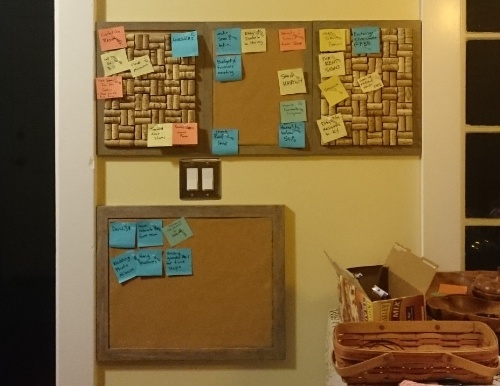LookFar Labs12 August 2015
Scrum and Marriage
Bringing Your Work Home Isn’t Always a Bad Thing
My wife and I got married a few months ago. She got a new job, my own company has made some major changes, and we bought a house.
It’s been a big year.
Keeping all of our to-do lists in order was becoming a pain. They were mostly in my head, and after the third time I forgot to drop off the same form at the insurance agency, my wife got fed up.
We needed to solve this, or I needed to buy a more comfortable couch to sleep on.
My wife, saint that she is, suggested a solution. We both work at Agile software shops and follow the Scrum methodology. Scrum has a lot of points in its favor (not the least of which is how easy it is to make puns off of), and it also has a lot of much-needed rules.
We would use that workplace model to run our house.
Scrum Methodology 101
The concept of Scrum in project management isn’t too hard to explain, so here’s a brief rundown:
In software development, Scrum teams will set a time box (usually 2 weeks), plan every task to be accomplished in those two weeks, then take some time to reflect once that box completes to see what worked, and what held them up.
Scrum teams keep a backlog of all the things they want to work on sometime in the future, and for each time-boxed period (“sprint”) they select tasks (“stories”) that are both high priority and achievable.
If a task is too big, it’s broken down into smaller tasks. Each task receives a certain difficulty rating (“points”). Once the team has enough cumulative points for the sprint, they stop adding new stories, since it would be unrealistic to do more.
Each sprint starts with a Sprint Planning Meeting with all stakeholders, planning the stories and giving each story the correct number of points.
5 minute Stand Up meetings are held every day to discuss achievements from the previous day, report any hold ups, and explain what each team member hopes to accomplish moving forward.
At the end of a sprint, teams hold a retrospective meeting to analyze their performance and lay down some constructive criticism.
During a sprint, tasks move from “To Do” into “In Progress” and once completed move to “Finished”. Each of these stages is called a lane.
How Our Process Works
The key component of Scrum-for-home in my experience has been time boxing.
While all of us have the occasional very-time-sensitive chore to handle, most home tasks fall into one of two categories: needs to be done sometime this week, or needs to be done sometime within the next 6 months.
It turns out a time-boxed Scrum process handles the two situations very nicely.
We have 4 physical scrum boards in our kitchen, plus a bunch of thumbtacks and index cards. When we think of a task, we write it on an index card and tack it to the backlog board (it’s the largest board).

Every Sunday night, we look at our “Finished” lane and congratulate ourselves for what we accomplished. Then we lay out all the backlog cards on our kitchen table and pick out the stories to do during the upcoming sprint.
Our sprints last one week and run Monday to Sunday. Every day before leaving the house we take a quick look over the boards to see what we need to do and what we need to complete.
The house rule is that if a task isn’t on the scrum board, we can’t get in trouble for not doing it. We make the sprint as a team and support each other to accomplish what we set out to do.
What We Don’t Do
Points were one of the first things to go. Points work very well when you have a set schedule and can reasonably estimate how much time you have to accomplish all of your work every sprint. For example, I work 40 hours a week, 80 hours a sprint. I can usually accomplish ~30 points per sprint.
But outside of work, we have an unpredictable social calendar, and while I can have every night and weekend day free one week, I might only have 1 weekday evening free and a packed weekend the next.
It also lead to unfair comparisons of the amount of home work being done (“Well you only did 15 points this week and I did 22!”). Points – no good.
We also don’t do stand-ups. Or at least, we don’t do them formally. We’re so connected via IM, chat, and our shared commute to work that it didn’t make sense for us.
For a couple with less face-to-face time than us, it could make sense to take 5 minutes a day to talk about the tasks needing to be done, but we had no problem getting that time in without a scheduled meeting.
Daily Chores. Recurring chores don’t make it to the board on a regular basis. Things such as “Dishes” or “Laundry” don’t have cards at all, they’re expected.
Bi-weekly tasks (items such as “Vacuum”, “Clean the Bathroom”, or “Mow the Lawn”) have cards, but we try not to use them. However, if they haven’t gotten done by their normally scheduled time, we have added them to the sprint to make sure they’re addressed.
The Scrum-at-Home Experience
The scrum process works beautifully as a tool to keep us focused on what to do in the short and medium term. It helps us focus and cooperate, and helps to keep me on task and out of trouble with my wife.
I’ve found the time-boxing aspect to be invaluable in real life. Shifting the focus of scrum from iteration to time-boxing has proven to be a winning direction to keeping our house in order, and our chore list manageable.
Written by
 Are your software maintenance costs outweighing the software’s value?
Are your software maintenance costs outweighing the software’s value?  Signal-Based Selling FTW with Creative Service Agencies
Signal-Based Selling FTW with Creative Service Agencies